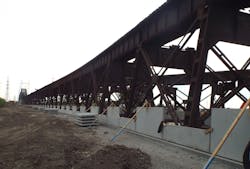Modified MSE wall construction over Mississippi River minimizes railroad downtime
Merchants Bridge crosses the Mississippi River, connecting St. Louis, Mo., to Venice, Ill. The bridge was initially constructed in the late 1800s and is the oldest rail structure crossing the Mississippi River. Among the many maintenance activities throughout the 1900s, the original timber trestles used on the approaches were eventually replaced with steel. As one of the busiest freight rail crossings over the Mississippi River, the bridge’s lifespan is nearing an end, and can no longer support the capacity required for the rail industry through the region.
The bridge is currently being renovated to increase capacity and meet new engineering standards. Due to the high volume of freight traffic, it is a priority for the owner that the project optimizes construction schedule and minimizes track downtime. Deconstructing the existing approach trestles and rebuilding them would mean the railway would be out of service for months, resulting in large-scale losses for the freight industry.
The engineers needed a solution for reconstructing the approaches to the bridge that would create minimal disruption to the freight rail industry crossing the bridge.
In the early stages of construction, The Reinforced Earth Company provided the contractor with a unique solution for renovating the bridge’s approach on the Missouri side. The solution used a modified MSE wall design that would allow for the existing trestle to be left in place so that the railroad could continue to operate during most of the construction.
The trestle volume was filled from the bottom up with low-density cellular concrete (LDCC), enclosed by concrete panels, which were anchored to the fill with steel MSE soil reinforcements. MSE walls are typically constructed using granular backfill, however in this case the use of a conventional MSE wall would require more labor and time to compact the fill inside the volume around the existing trestle. The LDCC was flowable, required no compaction effort and was placed in vertical lifts larger than a granular backfill would be. After the walls were constructed to the required grade, rail traffic was stopped, and new tracks were installed.
The modified MSE walls with LDCC fill do not behave as a typical MSE wall, but on this project it provided the needed benefit to the construction timeline and railroad’s schedule. More information about the use of LDCC fill in MSE walls can be found by contacting The Reinforced Earth Company or visiting the ASCE Library for the recently published paper titled, Low-Density Cellular Concrete in MSE Structures with Steel Strip Reinforcements—Design and Construction Considerations and Case Histories.
